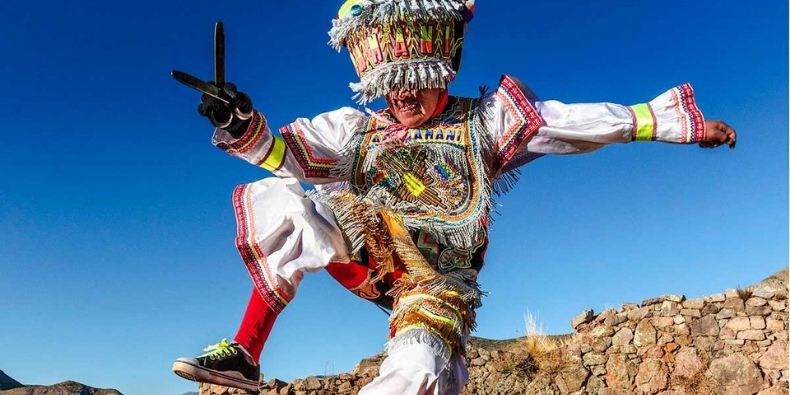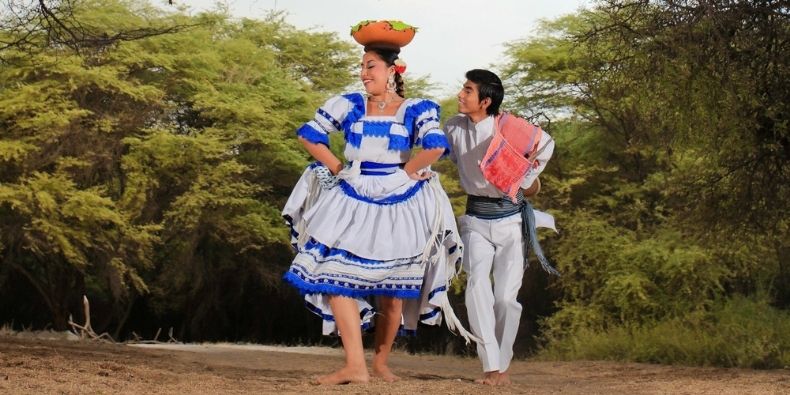Peru was the cradle of many important civilizations, some even older than the Incas, that traced the path towards a distinctive cultural expression that evolved overtime. With the arrival of the Spanish colonizers, new traditions were introduced that eventually changed the way of living of the ancient Peruvians.
Furthermore, African, Asian and European influences contributed to the historical and cultural development of the country. These different cultures allowed the consolidation of a cultural expression where exotic flavors, interesting customs, harmonious sounds and lovely dances make it even more diverse.
Nowadays, religious and civic celebrations are a scream of rejoice during the holidays or special occasions and often portray traditional dances and music that depict the passion and mysticism of its inhabitants.
Peru’s typical dances are a cultural manifestation that tells the story of the country’s evolution. Some of these dances were recognized by Unesco and listed as Intangible Cultural Heritage of Humanity. Here we’ve gathered four of the most popular that you can experience on your next trip!
The Marinera

Considered as the most emblematic traditional dance of Peru and certainly the most romantic, it is the most popular tradition in northern Peru, specially in Trujillo. This Cultural Heritage of the Nation since 1986 performs a courtship dance between a couple with gracious, elegant and flirtatious gestures.
There are many variations of this dance, where three regions such as Trujillo, Lima and Puno, have distinguished differences between music lyrics, sounds and movements but they all look to show the same message.
The Marinera is so popular in northern Peru that the National Marinera Contest is held every year, where hundreds of contestants compete to be the best Marinera couple. It takes place at the end of January in the city of Trujillo attracting thousands of foreign and national travelers.
When it comes to its music, it has become a Peruvian genre with a nationalist connotation that owns a distinctive identity.
Although it may vary according to the different regions of the territory, it is mainly composed of: A tarola and/or cajón base (instrument), guitar accompaniment, one “voice” played with saxophone and trumpet, a second voice played with tuba, trombone and clarinet, and violin accompaniment which tends to be optional.
Danza de Tijeras (Dance of Scissors)

This is the most mystical dance of the country, where its dancers act as mediators of Mother Earth and the Andes to the villagers. This dance originated in the Chanka region of Peru and it’s known with different names in the areas of Huancavelica, Ayacucho and Apurímac.
This is a very strenuous dance, where the performer has to train very hard to do the acrobacies and swift moves involved in this impressive dance. This performance is carried out in civic and religious celebrations, mostly in the countryside of the aforementioned regions.
During the pre-hispanic era, the dancers were descendants of priests, fortune tellers, witches and shamans that were persecuted during the colonization process. They were often called Supaypa Wawan in Quechua, which translates to Sons of the Devil.
The catholic priests believed that the mystical side to this dance implied a pact with the devil, due to the ‘scissors’ they used and the movements they performed throughout the dance. These scissors were elaborated with two metal plates of 25 cm that together formed a pair of blunt-tipped scissors.
To master this choreography, danzers from different Andean communities have been trained since they were kids because it requires intense physical preparation. Each dancer receives a name associated with a mountain spirit so they dance under its protection.
Its musical framework is provided by violin and harp, the Dance of Scissors follows its sequence though it varies thoroughly and progressively increases as the dance moves become riskier.
El Huayno

This is the oldest dance in Peru since it was traced back to the pre-Hispanic era, mostly practiced in the Andean highlands. The Huayno is the cultural representation of the Andean native Peruvian and though its music and choreographies vary according to each region, they all maintain the same spirit.
According to historians, the Huayno could have been a sort of militar himn, and as new musical instruments and techniques were introduced with the arrival of the Spanish, this dance and musical genre was totally transformed.
It is mostly danced by couples and represents enthusiasm, love, joy, motivation, life and spirituality. The lyrics and sounds of this popular Andean music often manifest joy and playfulness, but also sadness and melancholy.
The instruments used in the performance of the huayno are the quena, charango, mandolin, harp, requinto, bandurria, guitar and violin. However, as it may vary, some traditional bands add trumpets, saxophones and acordeons to the mix.
El Tondero

Although it may be considered quite similar to the Marinera, this dance has a more rebellious and bandit spirit. It is very popular in northern Peru and just like the Marinera dance, its choreography also represents the courtship and falling in love of a couple.
Unlike the rest of creole genre influenced by Spanish culture, the Tondero originated from the mixture of cultures from the countryside and the Yunga region. The Morropón town in Piura is considered the capital of this dance.
The first appearances of this dance were accompanied by harmonic harp sounds and later on guitar sounds and Peruvian cajón were included. Each region in northern Peru has its own version but the classic one includes: A main vocalist, a small choir, two guitar players, two Peruvian cajones players and, as odd as it sounds, a wooden spoon player.
There is no doubt when we say that Peru has one of the most diverse cultures in the South American continent. Besides the many dances and music in this country, there are thousands of Peruvian cultural celebrations that you should know about.
Make the most of your experience and learn everything about the magic behind the ancient country of the Incas. We encourage you to check these Peru travel packages for more inspiration!

